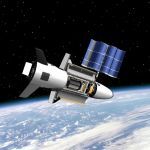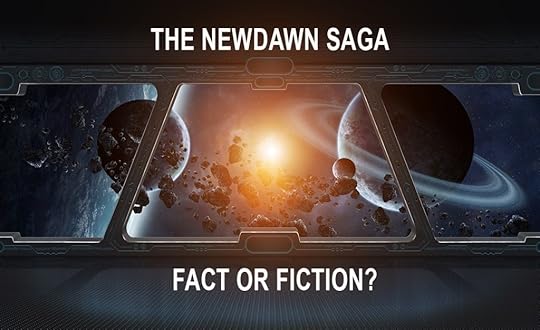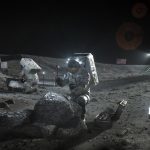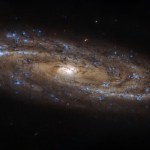Dominique Luchart's Blog, page 744
May 6, 2020
The US Space Force is recruiting (and has a snazzy promo video just for you), Tariq Malik,

It’s official: The U.S. Space Force wants you to join the ranks of the newest branch of the American Armed Forces.
In a new recruitment video unveiled today (May 6), the Space Force makes its case for a military life among the stars.
“Some people look to the stars and ask, ‘What if?'” the video says. “Our job is to have an answer.” Space Force officials shared the video on social media with a link to a recruitment website here.
Related: Not enough Americans understand the need for Space Force
[image error]
A still from the U.S. Space Force’s first promotional video released on May 6, 2020. (Image credit: U.S. Space Force)The Space Force is the sixth and newest branch of the U.S. military and was ordered by President Donald Trump to oversee U.S. military activities in space. It was officially established in December when Trump signed the 2020 National Defense Authorization Act. The Space Force is part of the Department of the Air Force, much like the U.S. Marine Corps is part of the Department of the Navy.
In recent months, Space Force officials have weighed in on a Russian anti-satellite test, launched a website, unveiled a logo, welcomed its first 86 graduates from the U.S. Air Force Academy and, on May 1, began taking transfer applications from active service members hoping to snag a spot in the space-focused military branch.
The Space Force’s promotional video offers tantalizing glimpses of U.S military activities in space. The military has constellations of communication, navigation and reconnaissance satellites in orbit, among other assets.
The video begins with what appears to be a potential recruit staring up into a starry night sky, then shifts quickly to scenes of rocket launches, astronauts, Space Force personnel and spaceflights. A United Launch Alliance Delta IV Heavy rocket makes a cameo, as does the Air Force’s X-37B space plane, a reusable robotic military spacecraft that flies on classified missions. (The sixth X-37B flight, called OTV-6, will launch May 16.) There’s even a fanciful deep-space vehicle that hints at Space Force missions beyond low-Earth orbit.
“Maybe your purpose on this planet isn’t on this planet,” the video adds as a zinger.
As promotional videos go, this one’s not bad. It’s catchy and fits in well with the Air Force’s “Aim High” and the Army’s “Be All You Can Be” taglines.
“This is an historic time to be in the space business and I could not be more excited to extend the opportunity to our active duty Air Force members to officially transfer into the Space Force,” Gen. Jay Raymond, Space Force Chief of Space Operations and U.S. Space Command Commander, said in a statement last month to active duty service members looking to transfer to the branch. “We have the unique opportunity to create a new service; your energy, passion and expertise will be critical to our success.”
Email Tariq Malik at tmalik@space.com or follow him @tariqjmalik . Follow us @Spacedotcom , Facebook and Instagram .
Join our Space Forums to keep talking space on the latest missions, night sky and more! And if you have a news tip, correction or comment, let us know at: community@space.com.
The post The US Space Force is recruiting (and has a snazzy promo video just for you), Tariq Malik, appeared first on NEWDAWN Blog.
Astrophysicist Katie Mack talks the end of the universe tonight! Here’s how to watch live., Mike Wall,

Astrophysicist Katie Mack will talk about the end of the universe today (May 6), and you can follow the discussion live — and even ask her a question, if you’d like.
Mack, an assistant professor at North Carolina State University and a popular science communicator, will participate in a webcast conversation this evening at 7 p.m. EDT (2300 GMT) hosted by the Perimeter Institute for Theoretical Physics in Canada. You can watch it live here at Space.com, courtesy of the Perimeter Institute, or directly via the Institute.
“Mack, who holds a Simons Emmy Noether Visiting Fellowship at Perimeter, will give viewers a sneak peek at her upcoming book, ‘The End of Everything (Astrophysically Speaking).’ She will then participate in a live ‘ask me anything’ session, answering questions submitted via social media using the hashtag #piLIVE,” Perimeter Institute representatives wrote in a description of the event.
So tune in, unless you already know how everything ends!
Mike Wall is the author of “ Out There ” (Grand Central Publishing, 2018; illustrated by Karl Tate ), a book about the search for alien life. Follow him on Twitter @michaeldwall . Follow us on Twitter @Spacedotcom or Facebook .
Join our Space Forums to keep talking space on the latest missions, night sky and more! And if you have a news tip, correction or comment, let us know at: community@space.com.
The post Astrophysicist Katie Mack talks the end of the universe tonight! Here’s how to watch live., Mike Wall, appeared first on NEWDAWN Blog.
US Space Force to launch the next X-37B space plane mystery mission on May 16, Mike Wall,

The U.S. military’s mysterious X-37B space plane is just 10 days away from launching on its next mission.
The X-37B is scheduled to lift off atop a United Launch Alliance Atlas V rocket from Florida’s Cape Canaveral Air Force Station on May 16, kicking off the sixth mission for the robotic vehicle, Space Force and Air Force officials announced today (May 6).
“This important mission will host more experiments than any prior X-37B flight, including two NASA experiments,” Secretary of the Air Force Barbara Barrett said today during a webinar hosted by the nonprofit Space Foundation.
Related: The X-37B space plane: 6 surprising facts
[image error]
A U.S. Air Force X-37B space plane, encapsulated ahead of a planned May 16, 2020, launch. That liftoff will kick off the sixth mission for the X-37B program. (Image credit: U.S. Air Force)One of those NASA payloads will examine the effects of space radiation on seeds, and the other will assess the performance of various materials in the space environment, Barrett explained.
Another experiment, designed by the U.S. Naval Research Laboratory, “transforms solar power into radio-frequency microwave energy, then studies transmitting that energy to Earth,” she said.
[image error]
Another view of the encapsulated X-37B, a robotic vehicle that’s about 29 feet (8.8 meters) long. (Image credit: U.S. Air Force)The upcoming mission, known as OTV-6 (short for “Orbital Test Vehicle-6”) and Space Force-7, will also deploy FalconSat-8, a small satellite developed by the U.S. Air Force Academy that itself carries five separate experiments.
To accommodate these and other payloads, the space plane has been outfitted with a service module for OTV-6 — a first for the X-37B program, Air Force officials said in a statement today.
The Air Force has two X-37B vehicles that we know of, both of which were built by Boeing. The vehicles look like NASA’s old space shuttle orbiters, only much smaller. Each X-37B is 29 feet (8.8 meters) long by 9.5 feet (2.9 m) tall, with a wingspan of about 15 feet (4.6 m) and a payload bay the size of a pickup truck bed.
For comparison, each space shuttle was 122 feet (37 m) long with a wingspan of 78 feet (24 m).
[image error]
The United Launch Alliance Atlas V rocket that will launch the next X-37B mission stands stacked at Florida’s Cape Canaveral Air Force Station. (Image credit: United Launch Alliance)The X-37B allows the U.S. military to test a variety of new tech in the space environment and return the gear to the ground for analysis. Many of the payloads that go up are classified, and military officials tend not to disclose many details of the vehicles’ activities in orbit.
“The X-37B team continues to exemplify the kind of lean, agile and forward-leaning technology development we need as a nation in the space domain,” Gen. Jay Raymond, the U.S. Space Force Chief of Space Operations, said in today’s statement. (The newly formed Space Force, which is part of the Department of the Air Force, is responsible for X-37B launches, orbital operations and landings.)
“Each launch represents a significant milestone and advancement in terms of how we build, test and deploy space capabilities in a rapid and responsive manner,” Raymond added.
It’s unclear how long OTV-6 will last, but precedent suggests that the mission will be a sustained one. Each OTV flight has broken duration records for the program, and OTV-5, which landed in October 2019, circled Earth for 780 days.
The five previous X-37B missions racked up a combined 2,865 days in orbit, Barrett said. That’s about 7 years and 10 months of off-Earth technology testing.
Mike Wall is the author of “ Out There ” (Grand Central Publishing, 2018; illustrated by Karl Tate ), a book about the search for alien life. Follow him on Twitter @michaeldwall . Follow us on Twitter @Spacedotcom or Facebook .
The post US Space Force to launch the next X-37B space plane mystery mission on May 16, Mike Wall, appeared first on NEWDAWN Blog.
May 5, 2020
Steve Carell’s ‘Space Force’ farce will launch on Netflix May 29. See the new trailer., Chelsea Gohd,

Editor’s note: The “Space Force” trailer features strong language.
The U.S. Space Force faces the parody treatment in a brand new Netflix series aptly titled “Space Force.”
The show stars Steve Carell as General Mark R. Naird who, as you can see in the brand new trailer released today (May 5), is surprised to be given command of the brand new military branch “Space Force.”
This show takes the “workplace comedy” genre to a new, cosmic level. Instead of leading a small team at a paper company, like he did in “The Office,” Carell is leading the entire United States in space. Much like NASA’s current goals with the Artemis program, in the show, Gen. Naird’s prime objective seems to be to return land on the moon.
Related: 20 sci-fi movies and TV shows to binge watch on Netflix right now
Want to try Netflix? You can get a 30-day free trial now
Sign up for Netflix starting at $8.99/month.
[image error]
Steve Carrell will star in a new Netflix comedy series Space Force based on President Donald Trump’s push to establish a real military branch of the same name. (Image credit: Netflix)But, from the trailer, it seems as though Gen. Naird was set up to fail. As he walks through what is presumably Space Force’s headquarters, he overhears someone talking about him on the phone, saying “he is blowing it just like you thought … yeah, it is a complete shitshow.”
Gen. Naird seems a bit goofy to begin with and it’s clear from the trailer that, not only do people not take him that seriously, he is prone to mistakes. Big, explosive mistakes.
Carell seems perfectly suited for this character who, while a bit of a buffoon, seems truly dedicated to and excited about space exploration. “This is a great adventure we are embarking on today,” Gen. Naird says in the trailer. “There will be setbacks, but greatness was never won without sacrifice.”
In the same speech, he references the anniversary of Apollo 11, which landed astronauts on the moon in 1969. “Fifty years ago, our country put a man on the moon. Well, guess what, kids? We’re going back,” Gen. Naird said.
The trailer ends on a surreal note, with Gen. Naird dancing around his office while singing “Kokomo” by the Beach Boys. The show will also star John Malkovich, Ben Schwartz, Diana Silvers, Tawny Newsome, Lisa Kudrow, Jimmy O. Yang, Jane Lynch, Fred Willard and Noah Emmerich.
This show, which was created by Carell and writer Greg Daniels, who has worked on shows including “The Office” and “Saturday Night Live,” comes to Netflix on May 29.
Follow Chelsea Gohd on Twitter @chelsea_gohd . Follow us on Twitter @Spacedotcom and on Facebook .
Join our Space Forums to keep talking space on the latest missions, night sky and more! And if you have a news tip, correction or comment, let us know at: community@space.com.
The post Steve Carell’s ‘Space Force’ farce will launch on Netflix May 29. See the new trailer., Chelsea Gohd, appeared first on NEWDAWN Blog.
Tiny asteroid’s super-close Earth flyby shows planetary protection in action, scientists say, Meghan Bartels,
It was a bright speck in the night. On April 27, something caught the eyes of astronomers poring through data gathered by the Pan-STARRS Observatory in Hawaii: a previously unknown space rock, and one that was very, very close to Earth.
Coincidentally, the alert came as a rather large asteroid (called 1998 OR2) was making its closest approach to Earth. That space rock, which was discovered decades ago, is about 2.5 miles (4 kilometers) wide. On April 28, it flew by Earth at a range of about 3.9 million miles (6.3 million km), about 16 times the distance from Earth to the moon. That distance is pretty bland for Earth flybys; it was the asteroid’s size that made the event intriguing.
The Pan-STARRS observation, it turned out, represented the opposite combination of characteristics: a small asteroid and a close shave of a flyby. The initial sighting sent planetary defense experts around the world into a flurry of activity because the first hour of observations suggested the space rock, now dubbed 2020 HS7, had a 10% chance of colliding with Earth.
Related: Potentially dangerous asteroids (images)
Within an hour, other observatories around the world were also on the case, tracking the object. And as scientists gathered more measurements, their concerns dissipated: the object was going to pass safely by Earth. These observations also showed that the object was just 13 to 26 feet (4 to 8 meters) wide, suggesting that even if it had collided with Earth, it would simply burn up in the planet’s thick atmosphere.
“Small asteroids like 2020 HS7 safely pass by Earth a few times per month,” NASA’s Planetary Defense Officer Lindley Johnson said in a statement released on April 28. “It poses no threat to our planet, and even if it were on a collision path with Earth it is small enough that it would be disintegrated by our Earth’s atmosphere.”
Still, it was an impressively close flyby: According to the European Space Agency (ESA), 2020 HS7 passed by 26,550 miles (42,735 km) away from the center of the Earth and just 750 miles (1,200 km) from the nearest satellite in geostationary orbit, one of the more distant rings of satellites surrounding Earth. The space rock passed below the satellite and left it undamaged.
[image error]
An animated orbital diagram shows the four inner planets and asteroid 2020 HS7, including the space rock’s close pass by Earth in April. (Image credit: ESA)According to ESA, the flyby is one of the 50 closest on record, making it rather more interesting to scientists than the much-publicized (and more distant) flyby of the larger rock 1998 OR2 the same week.
Both flybys show the way planetary defense systems are designed to work: First, identify as many asteroids as possible, starting with the largest. Then, track them long enough to plot their orbits. The more data scientists can gather, the more accurate those orbits become, hence the downgrade from 10% chance of impact to a safe miss.
If more observations instead show the impact probability increasing, alert systems are enacted to prepare areas at risk and evaluate potential mitigation approaches — but those systems weren’t necessary for 2020 HS7.
Email Meghan Bartels at mbartels@space.com or follow her @meghanbartels. Follow us on Twitter @Spacedotcom and on Facebook.
Join our Space Forums to keep talking space on the latest missions, night sky and more! And if you have a news tip, correction or comment, let us know at: community@space.com.
The post Tiny asteroid’s super-close Earth flyby shows planetary protection in action, scientists say, Meghan Bartels, appeared first on NEWDAWN Blog.
May 1, 2020
THE NEWDAWN SAGA – FACT OR FICTION?
Science Fiction has never felt so real. Living in a pandemic, by yourself watching the news of the Pandemic or Net Flicks of the movie the Pandemic its hard to tell reality from fiction. If you can think it, it can become real. If you are on the last reruns of Star Trek with little choices left, try an incredible new book that has become the rave among its readers. The prequel of the NEWDAWN Saga – NewDawn Roamers.
 Window view of space and planets from a space station 3D rendering elements of this image furnished by NASA
Window view of space and planets from a space station 3D rendering elements of this image furnished by NASAThe First Living Robots – The First of its Kind is no Joke for the Future of Humanity…
We know it is just a matter of time before implants will lead us to a new generation of humans. Already today, we have implants helping the blind see shapes in black and white so they can move around more freely, and even brain implants helping with hand and arm motion. Imagine what it will be like when we are all stronger, healthier, and even faster to keep up with the Artificial Intelligence system that will oversee our entire world infrastructure? I promise this is not that far away!

Already, scientists have lifted cells from frog embryos and assembled them to create a new life form. These called “xenobots” can move around and heal themselves if damaged. Think about one millimeter wide bots that can be programmed to reach a target, perhaps even deliver a medicine payload to the intended cells within your body to help one heal? Well, this is some of the work developed by scientists like Joshua Bongard, a computer scientist and robotic expert working at the University of Vermont (UVM) who co-led the research on these “novel living machines.”
The Steps Toward a New Life Form
They do not belong to traditional robotics per se, nor do they meet with any known species of animals on the planet. They are, in effect, a new species, a new class of artefact, a living programmable organism.
Designed on a supercomputer at UVM, they were assembled and tested by biologists at Tuft University, Massachussets. Already many applications can be used with the “xenobots,” unlike other machines or robots, states Michael Levin at Tuft Center for Regenerative and Developmental Biology. They can indeed provide help in searching vile compound or radioactive contamination. They can travel in arteries and gather plaque on some patients. They can also collect microplastic in the oceans, something our planet dramatically needs.
We already know that scientists have manipulated and edited genetics around the world for food and even to replicate existing animals. However, this is a new step in research, and these organisms represent designed biological machines created from the ground up. The team at UVM’s Vermont Advanced Computer Core and Deep Green Supercomputer cluster, worked over months of computing to create thousand of candidates design for this new life-form based on an evolutionay algorithm. With assigned tasks given by scientists, like locomotion in one direction, the computer would reassemble a few hundred simulated cells into a myriad of forms and simulated shapes and accomplished this over and over again. The programming, refined to include rules on biophysics, incorporated what a single skin and cardiac cells can achieve. The simulated organisms that were successful were refined, while the designs that failed were discarded. The elimination process took a hundred of independent runs of the algorithm. Only then did the most promising designs were chosen and tested.
Working diligently to bring the new life-form to life, the team at Tufts went to the next step. They then gathered stem cells from African frogs, and separated them into single-cell, living them to incubate. With tiny forceps and even smaller electrodes, the cells were cut and joined under a microscope with a close similarity to the selected designs.
The cells began to work together in a body form never seen before. Each provided with a specific purpose; the skin cells formed a passive architecture while the once-random heart muscle contraction granted a forward motion, based on the computer’s designs and aided by spontaneous, self-organizing patterns giving the robots the ability to move of their own.

The organisms were able to move coherently. They explored their watery environment for weeks, provided by embryonic energy stores. Groups of xenobots moved in a circle, pushing pellets in a central location, both spontaneously and collectively. A few organisms, built with a hole in the center to reduce drag, were repurposed by scientists in simulation to carry an object.
A Supercomputer Leads the Way
This is a step using computer design organisms for intelligent drug delivery, said Bongard. In further tests, the team even cut the xenobots almost in half, and it stitched itself together and kept going. This is not something that you see with typical robots. While with more work this may lead to breaking in some way the morphogenic code, it shed more light in the way organisms are structured and store information.
Enhanced Health and Abilities Through Genetic Manipulation, Nanotechnology and Living Robots
While we are not there yet, we certainly are on our way, and there is no doubt in my mind that by the end of the 21st century, we will see new life forms like these xenobots intervene in a standard health maintenance program. In NEWDAWN ROAMERS, Tesh, our heroine, loses the use of her left arm and is injected nanobots with the help of a HydroSheath to recover the full usage of her limb and by 2098, it is only one of the ways to enhance our physiology.
Genetic manipulation, nanotechnology, living robots are the wave of the future in maintaining our bodies healthy, and giving us a longer lifespan. While there is some concerns that we are opening the door to unforeseeable consequences with biology manipulation, if we are to thrive as a species, and if humanity is to survive in the future, our evolution will require that we integrate more complex systems. For this to happen, “we need to understand how complex properties, somehow emerge from simple rules,” said Levin. To avoid unintended consequences, “we need to get a better handle on systems where the outcome is very complex,” adds Levin.
I expose some of these concepts in NEWDAWN ROAMERS, my SciFi novel set in the near future – 2098, where not only do I deal with a planetary artificial intelligence system like DAINN, but also highlights some of the genetic engineerings that shapes an entirely new generation of humans.
NEWDAWN ROAMERS, more than a book, an entirely new universe!
The results of this research were published in Proceedings of the National Academy of Science.
Credit: Futuretimeline.net
The post THE NEWDAWN SAGA – FACT OR FICTION? appeared first on NEWDAWN Blog.
All-Star Cast Assembles for First Photos from Legendary’s ‘Dune’ Remake, Chris Arrant,

Vanity Fair has shared the first crop of photos from Legendary’s upcoming Dune remake. Here is a selection of them, from VF’s Twitter:
You can view even more photos here.
[image error]
“Dune, Arrakis, desert planet.” (Image credit: Legendary)“Dune” has an all-star cast which includes Timothee Chalamet, Rebecca Ferguson, Dave Bautista, Stellan Skarsgard, Charlotte Rampling, Javier Bardem, Josh Brolin, Zendaya, Oscar Isaac, and Jason Momoa.
“A mythic and emotionally charged hero’s journey, Dune tells the story of Paul Atreides, a brilliant and gifted young man born into a great destiny beyond his understanding, who must travel to the most dangerous planet in the universe to ensure the future of his family and his people. As malevolent forces explode into conflict over the planet’s exclusive supply of the most precious resource in existence — a commodity capable of unlocking humanity’s greatest potential — only those who can conquer their fear will survive.”
“Dune” is scheduled to hit theaters Dec. 18.
Originally published on Newsarama.
Join our Space Forums to keep talking space on the latest missions, night sky and more! And if you have a news tip, correction or comment, let us know at: community@space.com.
The post All-Star Cast Assembles for First Photos from Legendary’s ‘Dune’ Remake, Chris Arrant, appeared first on NEWDAWN Blog.
Beacon of hope? NASA sees inspiration parallels between Apollo and Artemis moonshots, Mike Wall,

NASA hopes its next moonshot will be a beacon of hope in troubled times, just as the first one was.
The space agency pulled off its famed Apollo moon landings during a time of incredible division and turmoil in the United States. Throughout the 1960s, the nation was wracked and riven by the Vietnam War, civil rights violations and protests, and high Cold War tensions, among other issues.
Apollo offered inspiration to Americans and people around the world back then, NASA Administrator Jim Bridenstine noted. And the space agency has a chance to do something similar today with its Artemis program of lunar exploration, he said.
Related: NASA unveils plan for Artemis ‘base camp’ on the moon beyond 2024
“It’s important that this agency do this now, because our country — and, in fact, the whole world — has been shaken by this coronavirus pandemic,” Bridenstine said Thursday (April 30) during a teleconference with reporters.
“We need to give people hope, we need to give them something that they can look up to, dream about — something that will inspire not just the nation but the entire world,” he added. “And I think that’s what NASA does.”
Artemis is working to land astronauts — including the first-ever female moonwalker — near the lunar south pole in 2024. That will be a very big deal indeed; nobody has set foot on the moon since the Apollo 17 crew departed in December 1972.
Artemis also aims to establish a long-term human presence on and around the moon by 2028. Bridenstine and other officials believe that the skills and techniques NASA learns to make this happen will help the space agency pull off the next giant leap, a crewed mission to Mars, in the 2030s.
Thursday’s teleconference delivered some significant Artemis news: NASA has awarded contracts to three industry teams to develop crewed moon landers for the program. SpaceX, Dynetics and a consortium led by Blue Origin will share $967 million to develop their concepts over the next 10 months.
NASA will assess the designs over this period, then select one or more to be matured. Eventually, the agency will procure crewed landing services from the vehicles that make it all the way through the development phase.
The landing system is one of several big architectural pieces that need to fall into place quickly to make the 2024 landing happen. The others are the huge Space Launch System (SLS) rocket and Orion crew capsule, which together will get astronauts off Earth and on their way to the moon.
Orion has one test flight under its belt, an uncrewed mission to Earth orbit that launched in December 2014 atop a United Launch Alliance Delta IV Heavy rocket. SLS has not yet left the ground; its first flight, which will send an uncrewed Orion around the moon, is expected to launch in mid-2021.
NASA also plans to assemble a small space station called the Gateway in lunar orbit. Gateway is a significant part of the overall Artemis plan; the outpost will serve as a staging point for sorties, both crewed and uncrewed, to the lunar surface. But the 2024 landing probably will not involve Gateway, Bridenstine said on Thursday.
Mike Wall is the author of “ Out There ” (Grand Central Publishing, 2018; illustrated by Karl Tate ), a book about the search for alien life. Follow him on Twitter @michaeldwall . Follow us on Twitter @Spacedotcom or Facebook .
Join our Space Forums to keep talking space on the latest missions, night sky and more! And if you have a news tip, correction or comment, let us know at: community@space.com.
The post Beacon of hope? NASA sees inspiration parallels between Apollo and Artemis moonshots, Mike Wall, appeared first on NEWDAWN Blog.
Pictures from space! Our image of the day, Space.com Staff,

Space can be a wondrous place, and we’ve got the pictures to prove it! Take a look at our favorite pictures from space here, and if you’re wondering what happened today in space history don’t miss our On This Day in Space video show here!
“Stretched” spiral galaxy bursts with baby stars
[image error]
(Image credit: ESA/NASA/Hubble/L. Ho)Friday, May 1, 2020: A new image from the Hubble Space Telescope features the sparkling spiral galaxy NGC 4100, which is teeming with baby stars. The galaxy’s spiral arms are speckled with pockets of bright blue starlight radiating from hot newborn stars. NGC 4100 is located about 67 million light-years from Earth in the constellation Ursa Major, and it belongs to a group of galaxies called the Ursa Major Cluster. It’s about three-quarters the size of the Milky Way, which is also a spiral galaxy, and it “looks almost stretched across the sky” in this new view, Hubble scientists said in a statement. The space telescope captured this image using its Advanced Camera for Surveys, and it was released today (May 1). — Hanneke Weitering
“Spiders” spotted on Mars
[image error]
(Image credit: NASA/JPL/UArizona)Thursday, April 30, 2020: Strange, spider-like features creep on the surface of Mars in this image taken by the High-Resolution Imaging Science Experiment (HiRISE) camera on board NASA’s Mars Reconnaissance Orbiter. These spidery landforms are what scientists call “araneiform” terrain, which literally translates to “spider-like.” The features arise because the Red Planet’s climate is so cold that during the Martian winter, carbon dioxide freezes from the atmosphere and accumulates as ice on the surface. When that ice begins to thaw in the spring, that carbon dioxide sublimates back into the atmosphere, or turns from a solid to a gas, leaving behind deep troughs in the terrain as gas is trapped below the surface. — Hanneke Weitering
Dwarf galaxy “steals the show” in Hubble image
[image error]
(Image credit: ESA/NASA/Hubble/T. Armandroff)Wednesday, April 29, 2020: In a deep-space image featuring countless distant galaxies of all shapes and sizes, a tiny dwarf galaxy takes center stage. The small elliptical galaxy in the foreground of this new Hubble Space Telescope image is known as PGC 29388. It contains between 100 million to a few billion stars, which pales in comparison to our Milky Way galaxy, which has 250 to 400 billion stars. “As beautiful as the surrounding space may be, the sparkling galaxy in the foreground of this image from the NASA/ESA Hubble Space Telescope undeniably steals the show,” Hubble scientists said in a statement. The image was released on April 20, a few days before the telescope celebrated its 30th anniversary. — Hanneke Weitering
Milky Way sparkles over La Silla
[image error]
(Image credit: Petr Horalek/ESO)Tuesday, April 28, 2020: The arc of the Milky Way galaxy shimmers over the La Silla Observatory in Chile in this gorgeous night-sky view by European Southern Observatory (ESO) photo ambassador Petr Horalek. In the center of the image is the ESO 3.6-metre telescope, and to its left is the Swiss 1.2-metre Leonhard Euler telescope. Visible beneath the righthand limb of the Milky Way’s starry arc are the Large and Small Magellanic Clouds, two satellite galaxies of the Milky Way. Saturn is visible under the left side of the arc, with Jupiter glowing brightly just above it and slightly to the left. You can see more in a 360-degree panoramic version of this image here. — Hanneke Weitering
Venus meets the crescent moon
[image error]
(Image credit: Gianluca Masi/The Virtual Telescope Project)Monday, April 27, 2020: The bright “evening star” Venus shines near the crescent moon in this photo captured by astrophysicist Gianluca Masi of the Virtual Telescope Project in Rome. Venus and the moon made a close approach in the evening sky yesterday (April 26), and the planet will reach its greatest brightness of the year tomorrow (April 28). — Hanneke Weitering
Hubble captures a “cosmic reef”
[image error]
(Image credit: NASA/ESA/STScI)Friday, April 24, 2020: Happy birthday, Hubble! To celebrate the 30th anniversary of the launch of the Hubble Space Telescope, NASA released this new image of a “cosmic undersea world” that is teeming with stars and colorful clouds of interstellar dust and gas. The image features the giant red nebula NGC 2014 and its smaller blue companion NGC 2020, both located in the Large Magellanic Cloud, a small satellite galaxy of the Milky Way located 163,000 light-years from Earth. Hubble scientists have nicknamed the image the “Cosmic Reef,” because the large nebula “resembles part of a coral reef floating in a vast sea of stars,” Hubble officials said in a statement. — Hanneke Weitering
A Lyrid meteor and the Milky Way
[image error]
(Image credit: Courtesy of Tina Pappas Lee)Thursday, April 23, 2020: A “shooting star” crosses the Milky Way galaxy in this photo taken during the peak of the annual Lyrid meteor shower. Photographer Tina Pappas Lee captured this view from Fripp Island, South Carolina, on Wednesday (April 22) at approximately 4:45 a.m. local time. Directly below the meteor, two of the brightest planets in the night sky, Jupiter and Saturn, are visible side by side. — Hanneke Weitering
Apollo 16’s “Earthrise”
[image error]
(Image credit: NASA)Wednesday, April 22, 2020: Happy Earth Day from space! This stunning view of Earth rising above the lunar horizon was captured by NASA’s Apollo 16 crew shortly before they landed on the moon 48 years ago. The astronauts snapped this picture, which appears to have been inspired by Apollo 13’s famous “Earthrise” photo, on April 20, 1972, the same day the lunar module Orion touched down on the surface with NASA astronauts John Young, Apollo 16 commander, and lunar module pilot Charlie Duke. Command module pilot Ken Mattingly stayed in orbit during their 71-hour stay on on the surface. — Hanneke Weitering
[image error]
(Image credit: NASA)Tuesday, April 21, 2020: A chain of SpaceX’s Starlink internet satellites orbits over Earth’s lime-green auroras in this photo captured by an astronaut at the International Space Station. The tiny satellite trails were captured on Monday (April 13) at 5:25 p.m. EDT (2125 GMT), as the station was passing over the southern Indian Ocean at an altitude of about 231 nautical miles (428 kilometers), NASA said in an image description. The satellites pictured here appear to belong to the fifth batch of approximately 60 satellites that SpaceX has launched for its new Starlink constellation, according to Jonathan McDowell, an astronomer at the Harvard-Smithsonian Center for Astrophysics who avidly tracks objects in Earth’s orbit. The company plans to launch its seventh batch of satellites on Wednesday (April 22). — Hanneke Weitering
Related:
No, they’re not aliens — SpaceX’s Starlink satellites surprise British skywatchers
Meteor and the Milky Way over La Silla
[image error]
(Image credit: M. Zamani/ESO)Monday, April 20, 2020: A “shooting star” streaks through the night sky near the Large and Small Magellanic Clouds, two of Earth’s galactic neighbors, in this photo from the La Silla Observatory in Chile. In the foreground of the image are two of the three new ExTrA (Exoplanets in Transits and their Atmospheres) telescopes at the observatory. — Hanneke Weitering
[image error]
(Image credit: Andrey Shelepin/NASA/GCTC)Friday, April 17, 2020: The Soyuz MS-15 spacecraft carrying three astronauts back from the International Space Station parachutes down to Earth before landing in Kazakhstan. NASA astronauts Jessica Meir and Drew Morgan and their Russian crewmember Oleg Skripochka of Roscosmos safely touched down today at 1:16:43 a.m. EDT (0516 GMT or 11:16 a.m. local Kazakh time), southeast of the town of Dzhezkazgan. — Hanneke Weitering
Hubble eyes a multiring galaxy
[image error]
(Image credit: ESA/NASA/Hubble/J. Greene)Thursday, April 16, 2020: The Hubble Space Telescope has captured this new view of a peculiar spiral galaxy with rings within its winding galactic arms. Known as NGC 2273, this galaxy is officially designated as a barred spiral, meaning that it has a central bar of stars and pinwheeling arms. But this galaxy also has several ring structures within its spiral arms. NGC 2273 hosts one inner ring along with two outer “pseudorings.” Astronomers believe these rings were created by spiral arms appearing to wind up tightly into a closed loop. — Hanneke Weitering
[image error]
(Image credit: NASA)Wednesday, April 15, 2020: Earth’s fluffy clouds and blue horizon provide a gorgeous backdrop for the Soyuz MS-16 crew spacecraft, seen here approaching the International Space Station with three Expedition 63 crewmembers on board. The Soyuz arrived at the orbiting lab on Thursday (April 9) with NASA astronaut Chris Cassidy and Russian cosmonauts Anatoly Ivanishin and Ivan Vagner. An astronaut at the International Space Station captured this image from approximately 250 miles (400 kilometers) above the Pacific Ocean, near the coast of Peru. — Hanneke Weitering
A shimmering dance
[image error]
(Image credit: NASA)Tuesday, April 14, 2020: An astronaut on the International Space Station captured this image of the aurora australis over the Indian Ocean on April 8, 2020. At the time, the space station was near the southernmost point in its orbit, and preparing for the arrival of three new crewmembers. — Meghan Bartels
Goodbye, Earth!
[image error]
(Image credit: ESA/BepiColombo/MTM, CC BY-SA 3.0 IGO)Monday, April 13, 2020: On April 10, the European-Japanese spacecraft BepiColombo conducted a flyby of Earth, which slowed the probe’s speed enough to turn its trajectory toward the inner solar system. The next day, the spacecraft took its final image of Earth, a delicate bright crescent in the vastness of space. — Meghan Bartels
The day before launch
[image error]
(Image credit: NASA)Friday, April 10, 2020: Fifty years ago today, NASA astronauts Jack Swigert, Jim Lovell and Fred Haise posed with a model of the spacecraft they would launch on the next day for the mission dubbed Apollo 13. The flight was plagued with challenges even before launch, and the crew would experience a catastrophic explosion in the mission’s service module, but all three returned to Earth safely. — Meghan Bartels
Expedition 63 lifts off
[image error]
(Image credit: Andrey Shelepin/NASA/GCTC)Thursday, April 9, 2020: A Russian Soyuz rocket soars toward the International Space Station with three Expedition 63 crewmembers after lifting off from the Baikonur Cosmodrome in Kazakhstan today (April 9) at 4:05 a.m. EDT (0805 GMT or 1:05 p.m. local Kazakh time). The Soyuz MS-16 crew capsule safely arrived at the orbiting laboratory about six hours later, with NASA astronaut Chris Cassidy and Russian cosmonauts Anatoli Ivanishin and Ivan Vagner on board. — Hanneke Weitering
“Pink Moon” seen from space
[image error]
(Image credit: NASA)Wednesday, April 8, 2020: The nearly-full Pink Moon rises over a cloud-covered Earth in this photo taken by an astronaut at the International Space Station. This photo was taken on Monday (April 6), one day before the supermoon, or a full moon that coincides with the moon’s perigee, the closest point to Earth in its orbit. Because the full moon of April is traditionally called the Pink Moon, last night’s supermoon has been referred to as the “Super Pink Moon.” — Hanneke Weitering
Juno spots hazy clouds on Jupiter
[image error]
(Image credit: Petr Horalek/ESO)Thursday, March 19, 2020: In this stunning night sky photo, the full arc of the Milky Way galaxy glitters over a photographer’s shadow at the construction site for the European Southern Observatory’s Extremely Large Telescope (ELT), on the Chilean mountain Cerro Armazones. Scheduled to open in 2025, ELT will be “the world’s biggest eye on the sky,” with a 39-meter (128-foot) primary mirror. ELT will scan the skies in optical and near-infrared wavelengths of light to search for worlds beyond our solar system, particularly for potentially Earth-like exoplanets. It will also help astronomers study how planets, stars, galaxies and black holes formed in the early universe. — Hanneke Weitering
A stellar nursery in the Tarantula Nebula
[image error]
(Image credit: Jessica Meir/NASA/Twitter)Thursday, March 5, 2020: A new view of New York City captured from the International Space Station show’s the city’s skyline in incredible detail. NASA astronaut Jessica Meir photographed the city from the orbiting laboratory, which circles the Earth at an altitude of about 250 miles (400 kilometers). “Clear views of bustling #NYC day and night lately from @Space_Station,” Meir tweeted on Wednesday (March 4). “Central Park looks inviting. Midtown’s skyline reminds me of a metallic pin art impression.” — Hanneke Weitering
A portrait of Saturn’s moon Enceladus
[image error]
(Image credit: NASA/JPL-Caltech)Wednesday, March 4, 2020: A new global view of Saturn’s icy moon Enceladus shows the tiny satellite’s “tiger stripe” fissures and frosty plumes in stunning detail. This artist’s illustration of Enceladus was created from a global map that scientists working on NASA’s Cassini mission stitched together from images that the spacecraft collected during its first 10 years of exploring the Saturn system. — Hanneke Weitering
Merging storms spotted on Jupiter
[image error]
(Image credit: NASA/JPL-Caltech/SwRI/Tanya Oleksuik)Tuesday, March 3, 2020: Two white, oval-shaped storms in Jupiter’s atmosphere have been spotted merging into one. NASA’s Juno spacecraft caught these anticyclonic storms in the act using its JunoCam imager on Dec. 26, 2019, as the spacecraft was completing its 24th perijove, or close flyby of the planet. At the time, Juno was passing about 44,900 miles (72,200 kilometers) above Jupiter’s cloud tops at a latitude of about 60 degrees south.
NASA has been tracking the larger of the two merging storms for years, and scientists have watched it gobble up several smaller storms in the past, NASA said in a statement. It narrowly avoided a merger with this same storm just a few months before this image was captured, when the two made a close approach as they churned through the planet’s turbulent atmosphere. — Hanneke Weitering
Hubble spots a galactic “traffic jam”
[image error]
(Image credit: ESA/NASA/Hubble/P. Erwin et al.)Monday, March 2, 2020: A new image from the Hubble Space Telescope features the barred spiral galaxy NGC 3887, with its long, winding arms and bright galactic core. The German-English astronomer William Herschel discovered this galaxy, which is located 60 million light-years away from Earth, about 234 years ago. At the time, astronomers didn’t understand how such spiral arms could even exist, because they thought a galaxy’s spinning core would eventually wind them up so tightly that the spirals would disappear. It wasn’t until the 1960s that astronomers came up with an explanation.
“Rather than behaving like rigid structures, spiral arms are in fact areas of greater density in a galaxy’s disc, with dynamics similar to those of a traffic jam,” Hubble officials said in a statement. “The density of cars moving through a traffic jam increases at the center of the jam, where they move more slowly. Spiral arms function in a similar way; as gas and dust move through the density waves, they become compressed and linger, before moving out of them again.” — Hanneke Weitering
The post Pictures from space! Our image of the day, Space.com Staff, appeared first on NEWDAWN Blog.
Watch live: SpaceX, NASA preview 1st commercial crew launch to ISS, Space.com Staff,

Ahead of SpaceX’s historic Crew Dragon Demo-2 mission to the International Space Station — the first crew launch from U.S. soil in nearly a decade — NASA TV will air a series of mission briefings and live astronaut interviews today (May 1). You can watch it all live in the window above, courtesy of NASA TV.
SpaceX will launch its Crew Dragon spacecraft on its first crewed test flight to the International Space Station (ISS) on May 27, with NASA astronauts Doug Hurley and Bob Behnken on board. It will lift off on a Falcon 9 rocket from NASA’s Kennedy Space Center in Florida, at 4:32 p.m. EDT (2032 GMT).
Today’s NASA TV schedule includes:
11 a.m. EDT (1500 GMT) — Commercial Crew and ISS program overview briefing
12:30 p.m. EDT (1630 GMT) — SpaceX Demo-2 overview briefing
1:30 p.m. EDT (1730 GMT) — Video B-Roll feed of Demo-2 crew training
2 p.m. EDT (1800 GMT) — Demo-2 crew news conference
3:40-4:50 p.m. EDT (1940-2050 GMT) — Live interviews with Doug Hurley
5:25-6:05 p.m. EDT (2125-2205) — Live interviews with Bob Behnken
With the first mission to return human spaceflight launches to American soil now targeted to lift off May 27, NASA will highlight the historic flight with a series of news conferences Friday, May 1, that will air live on NASA Television and the agency’s website. In addition, NASA astronauts Robert Behnken and Douglas Hurley, who will serve as crew for the mission, will be available for remote interviews.
NASA’s Johnson Space Center in Houston will host a trio of media briefings beginning at 11 a.m. EDT May 1, to preview NASA’s SpaceX Demo-2 mission. The flight test with NASA astronauts aboard SpaceX’s Crew Dragon spacecraft will lift off on a Falcon 9 rocket to the International Space Station from NASA’s Kennedy Space Center in Florida.
All media participation in these news conferences and interviews will be remote; no media will be accommodated at any NASA site due to the COVID-19 pandemic. To participate in the briefings by phone or to request a remote interview with the crew members, reporters must email jsccommu@mail.nasa.gov no later than 5 p.m. Tuesday, April 28.
The May 1 briefings and participants include (all times EDT):
11 a.m. – Commercial Crew and International Space Station overview news conference with the following participants:
NASA Administrator Jim Bridenstine
Kathy Lueders, program manager, Commercial Crew Program, NASA’s Kennedy Space Center
Kirk Shireman, program manager, International Space Station Program, NASA’s Johnson Space Center
Gwynne Shotwell, president and chief operating officer, SpaceX
12:30 p.m. – Mission Overview news conference with the following participants:
Steve Stich, deputy manager, Commercial Crew Program, NASA’s Johnson Space Center
Zeb Scoville, NASA Demo-2 flight director, Flight Operations Directorate, NASA’s Johnson Space Center
Benji Reed, director of crew mission management, SpaceX
2 p.m. – Crew news conference with the following participants:
Astronaut Robert Behnken, joint operations commander, NASA’s SpaceX Demo-2 mission
Astronaut Douglas Hurley, spacecraft commander, NASA’s SpaceX Demo-2 mission
3:30 p.m. – Round-Robin interviews with the crew members:
Behnken and Hurley will be available for a limited number of remote interviews
Following a May 27 launch, Behnken and Hurley are scheduled to arrive at the space station May 28 to join Expedition 63 commander Chris Cassidy of NASA and flight engineers Anatoly Ivanishin and Ivan Vagner of the Russian space agency Roscosmos.
Behnken will be the joint operations commander for the Demo-2 mission, responsible for activities such as rendezvous, docking and undocking, as well as Demo-2 activities while the spacecraft is docked to the space station. Selected as a NASA astronaut in 2000, Behnken completed two space shuttle flights. He flew on STS-123 in March 2008 and STS-130 in February 2010 and conducted three spacewalks during each mission. Born in St. Anne, Missouri, he has bachelor’s degrees in physics and mechanical engineering from Washington University in St. Louis and earned a master’s and doctorate in mechanical engineering from the California Institute of Technology. Before joining NASA, Behnken was a flight test engineer with the U.S. Air Force.
Hurley will be the spacecraft commander for Demo-2, responsible for activities such as launch, landing and recovery. Selected as an astronaut in 2000, Hurley has completed two spaceflights. He served as pilot and lead robotics operator for both STS-127 in July 2009 and STS-135, the final space shuttle mission, in July 2011. The New York native was born in Endicott, but considers Apalachin his hometown. He holds a Bachelor of Science degree in civil engineering from Tulane University in Louisiana and graduated from the U.S. Naval Test Pilot School in Patuxent River, Maryland. Before joining NASA, he was a fighter pilot and test pilot in the U.S. Marine Corps.
Find out what the astronauts and cosmonauts aboard the International Space Station are up to by tuning in to the “ISS Live” broadcast. Hear conversations between the crew and mission controllers on Earth and watch them work inside the U.S. segment of the orbiting laboratory. When the crew is off duty, you can enjoy live views of Earth from Space. You can watch and listen in the window below, courtesy of NASA.
“Live video from the International Space Station includes internal views when the crew is on-duty and Earth views at other times. The video is accompanied by audio of conversations between the crew and Mission Control. This video is only available when the space station is in contact with the ground. During ‘loss of signal’ periods, viewers will see a blue screen.
“Since the station orbits the Earth once every 90 minutes, it experiences a sunrise or a sunset about every 45 minutes. When the station is in darkness, external camera video may appear black, but can sometimes provide spectacular views of lightning or city lights below.”
Follow us on Twitter @Spacedotcom and on Facebook .
The post Watch live: SpaceX, NASA preview 1st commercial crew launch to ISS, Space.com Staff, appeared first on NEWDAWN Blog.



